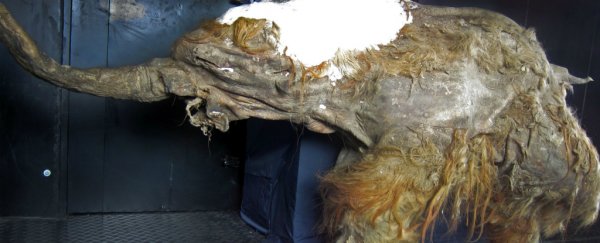One of the most legendary New York City dinner parties of all time was held in 1951 by the exclusive Explorers Club. It wasn't the guests that made the evening so notorious, it was the menu, which is rumoured to have included exotic delicacies such as Pacific spider crabs, bison steaks, and - wait for it - slices of a 250,000-year-old woolly mammoth that had been defrosted from Alaskan glacial ice.
That last dish in particular has remained a mystery over the past 65 years, with many people doubting whether guests could realistically have been served mammoth (not to mention the questionable ethics of eating an extinct species). In fact, many attendees claimed that the meat in the main entree was not from a mammoth, but from an extinct giant ground sloth. But now a new DNA analysis has finally solved the case of the mystery meat once and for all and, sorry guys, but you were all wrong.
After studying a leftover morsel of the alleged mammoth/ancient sloth meat that the Explorers Club had kept as a souvenir, scientists from Yale University were able to determine that the dinner guests were actually served green sea turtle (Chelonia mydas) - which was most likely leftover from the meat used in the soup course - and not the prehistoric meat they were told they were eating. Poor explorers…
"To me, this was a joke that no one got," said one of the researchers, Matt Davis. "It's like a Halloween party where you put your hand in spaghetti, but they tell you it's brains. In this case, everyone actually believed it."
So how did the Explorers Club manage to trick everyone into the mammoth thing in the first place? It all started when the banquet's promoter (and former agent to the film star Mae West), Commander Wendell Phillips Dodge, sent out a press release stating that the annual dinner would serve "prehistoric meat".
Many people jumped to the conclusion that this would be woolly mammoth, and a whole backstory developed about how the mammoth had been supplied by the Alaskan explorer Reverend Bernard Hubbard, who had found it frozen in the glacial ice in a cave off the south-west coast of Alaska.
But although a large number of the attendees believed they'd eaten mammoth, the rest were convinced it was a giant ground sloth species known as Megatherium. This idea was supported by the fact that the leftover chunk of meat from the dinner party, which was sent to the Bruce Museum in Greenwich, was labelled by Dodge as Magetherium.
 Yale Peabody Museum of Natural History
Yale Peabody Museum of Natural History
The only problem was that Megatherium never actually existed in Alaska, where it was claimed the meat was found. Despite all the inconsistencies, the stories continued to circulate, with the woolly mammoth version living on as something of a New York urban legend to this day - which is why the Yale team was so intrigued to analyse the sample.
The DNA analysis itself was a challenge, because the meat had been cooked before being preserved. But the researchers were able to extract mitochondrial DNA from the cells - which is DNA that's passed down only by females and is more resilient than regular DNA - and then sequence it. The results matched the genetic profile of green sea turtle.
It turns out that, in hindsight, the dinner guests probably should have been able to work that out themselves, with Dodge putting out a statement not long after the party which joked that he may have discovered a potion to turn green sea turtle into giant sloth meat. But you know what they say about letting the truth get in the way of a good story…
"I'm sure people wanted to believe it. They had no idea that many years later, a Ph.D. student would come along and figure this out with DNA sequencing techniques," said one of the researchers, Jessica Glass.
And as crazy as it sounds for people to fall for the defrosted mammoth story, it actually would be possible for us to eat the extinct species - but they'd be preserved in the frozen dirt of permafrost, not glacial ice.
"The meat wouldn't taste good, but you could eat it," said Davis.
The results have been published in PLOS ONE, and the Explorers Club admitted it was "pleased" with the findings, and the confirmation it didn't serve extinct food to its members all those years ago.
"The mindset 65 years ago and today has dramatically changed and what was obviously a unique event decades ago, has given way to a determined effort to introduce people to the foods that can sustain mankind well into the future," executive director Will Roseman told the Associated Press.

